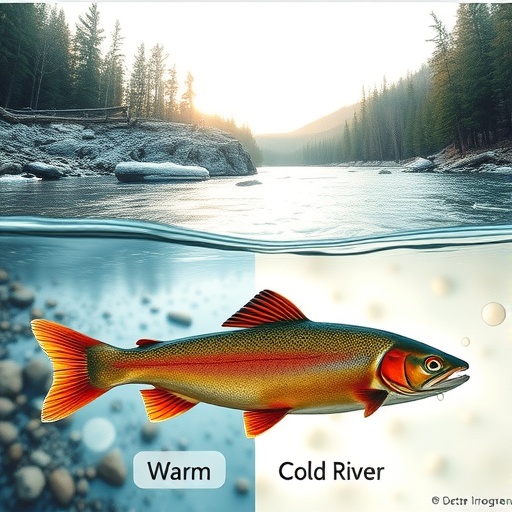In a groundbreaking study spanning nearly three decades, scientists have uncovered starkly contrasting trends in freshwater fish biodiversity across the thermal gradients of rivers and streams in the United States. This comprehensive analysis, empowered by harmonizing federal biomonitoring datasets encompassing 389 fish species from almost 3,000 sampling sites between 1993 and 2019, reveals a troubling decline in fish abundance and richness in cold-water streams alongside a surprising increase in biodiversity metrics in warmer streams.
Freshwater ecosystems worldwide are home to an astonishing diversity of fish species, exceeding 18,000 globally. These fishes play pivotal roles in maintaining aquatic ecological balance and provide significant cultural and economic value to human societies. However, this essential biodiversity faces escalating threats due to climate change and human-mediated disturbances such as the introduction of non-native species and extensive fish stocking practices.
The research team focused their lens on three distinct categories of streams delineated by historical summer temperature regimes: cold streams with temperatures below 15.4 °C, intermediate streams ranging from 15.4 to 23.8 °C, and warm streams exceeding 23.8 °C. Analysis revealed that cold streams suffered a dramatic 53.4% reduction in overall fish abundance and a 32% decline in species richness over the 27-year period. Paradoxically, though diversity fell, fish communities grew more unique, suggesting localized extinctions paired with the persistence of specialized taxa.
Delving deeper into the community composition dynamics, cold streams witnessed a marked increase in so-called “periodic” fish species—characterized by large body sizes and late maturity—paired with declines in “opportunistic” species that tend to be smaller with rapid life cycles. This pattern potentially reflects the influence of game fish proliferation, either native or introduced, which may exert predatory or competitive pressures reshaping assemblages. The interactions among these life-history traits and warming temperatures appear to select for species better adapted to slower, more competitive life strategies.
In stark contrast, warm streams displayed an inverse trend, where both fish abundance and richness increased by 70.5% and 15.6%, respectively. However, this increase masks an underlying homogenization of fish communities, driven by a dominance of opportunistic, small-bodied species that tend to rapidly reproduce and thrive in disturbed environments. These opportunists have effectively displaced larger, periodic fish species, reshaping community structure toward greater uniformity across sites.
Interestingly, intermediate temperature streams, which comprise the majority of waterways, showed minimal net changes in biodiversity metrics throughout the study period. These ecosystems currently appear poised in ecological stasis, but their future trajectories remain uncertain considering ongoing anthropogenic pressures and climatic fluctuations.
Statistical modeling of interactions between warming trends and fish introductions illuminated a concerning synergism that accelerates the degradation of native fish biodiversity. Specifically, warming waters exacerbate the impacts of invasive and stocked species, facilitating their establishment and spread while simultaneously stressing native communities adapted to cooler conditions. This compounding effect represents a critical threat to the persistence of native fish assemblages over spatial and temporal scales.
The findings highlight the urgency to implement effective management and conservation policies targeting both climate mitigation and invasive species control. Strategies must prioritize protection of cold stream habitats and restoration efforts to preserve their unique biotic communities. Simultaneously, there is a pressing need to regulate and monitor stocking practices and limit the introduction of non-native species, especially in climatically vulnerable ecosystems.
The study’s leveraging of diverse federal biomonitoring programs underscores the power of integrated datasets for unveiling subtle yet profound ecological transformations across broad spatial extents and temporal spans. Such large-scale ecological surveillance is indispensable for guiding adaptive management in facing the multifaceted challenges imposed by global change.
The nuanced picture emerging from this research urges a reconsideration of one-size-fits-all conservation approaches, advocating instead for tailored interventions cognizant of thermal regime-specific responses. The divergence of fish biodiversity trends across cold and warm streams exemplifies how climate change and human activities interact to sculpt aquatic communities heterogeneously.
As climate change continues unabated and human pressures intensify, understanding these complex ecological dynamics will be vital for safeguarding freshwater biodiversity. Rivers and streams represent living barometers of ecosystem health, and their fishes serve as both indicators and architects of aquatic integrity.
The dual phenomena of biodiversity decline and homogenization captured in this study convey a sobering message: without concerted efforts to arrest warming and limit biological invasions, extant freshwater fish diversity may erode beyond recovery, imperiling ecosystem functions and human livelihoods intertwined with these dynamic waterscapes.
This landmark contribution charts new directions for freshwater biodiversity science, emphasizing urgency, scale, and the interplay of multiple stressors in shaping the future of aquatic life. The authors call for global awareness and robust conservation action to stem this alarming trajectory and ensure vibrant, resilient rivers and streams for generations to come.
Subject of Research: Trends and drivers of freshwater fish biodiversity in U.S. rivers and streams under warming and invasive species pressure.
Article Title: Diverging fish biodiversity trends in cold and warm rivers and streams.
Article References:
Rumschlag, S.L., Gallagher, B., Hill, R. et al. Diverging fish biodiversity trends in cold and warm rivers and streams. Nature (2025). https://doi.org/10.1038/s41586-025-09556-0
Image Credits: AI Generated




